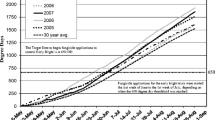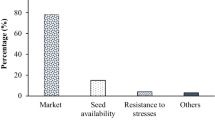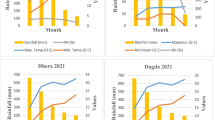Abstract
The aim of this five-year study was to identify economic fungicide treatments to control ascochyta blight in field pea in southern Australia. Results showed a complex interaction between a number of factors. There were clear patterns in efficacy of different fungicides in controlling disease however grain yield and financial gains were dependent on fungicide costs, seasonal conditions and yield potential. Disease suppression was achieved at early growth stages with fungicides applied as seed dressings or via fluid injection before sowing. Foliar fungicides were applied before or at canopy closure growth stage and early flowering. The foliar fungicides prothioconazole plus bixafen, azoxystrobin plus cyproconazole and pyraclostrobin were economic where grain yield was above 1.6 t ha− 1 but mancozeb, the traditional protectant fungicide for field pea, was not economic even where disease severity was reduced. Analysis of grain yield responses to ascochyta blight identified three groupings based on maximum grain yield potential and found ascochyta blight had greatest impact on grain yield in higher rainfall and higher yielding situations. In dry growing seasons with yield potential below 1.6 t ha− 1 the disease had no significant effect on grain yield and no fungicide strategy was economic irrespective of the disease control. A sowing date experiment confirmed that modern semi-leafless ‘afila’ erect field pea varieties are better suited to the combination of early sowing and economic disease management strategies to maximise grain yield in southern Australia than traditional conventional trailing types and have made redundant the advice to delay sowing as a means to avoid ascochyta blight.

Similar content being viewed by others
References
AEGIC (2020) Australian Grain note pulses. https://aegic.org.au/wp-content/uploads/2021/03/AEGIC-Grain-Note-pulses_LR-1.pdf (accessed 2/06/2021)
Bowness R, Gossen BD, Chang KF, Goswani R, Willenborg CJ, Holtz M, Strelkov SE (2016) Sensitivity of Mycosphaerella pinodes to pyraclostrobin fungicide. Plant Dis 100:192–199. https://doi.org/10.1094/PDIS-03-15-0350-RE
Bretag TW, Keane PJ, Price TV (1995) Effect of ascochyta blight on the grain yield of field peas (Pisum sativum L.) grown in southern Australia. Aust J Agric Res 35:531–536. https://doi.org/10.1071/EA9950531
Bretag TW, Keane PJ, Price TV (2000) Effect of sowing date on the severity of ascochyta blight in field pea (Pisum sativum L.) grown in the Wimmera region of Victoria. Aust J Exp Agric 40:1113–1119. https://doi.org/10.1071/EA00097
Bretag TW, Keane PJ, Price TV (2006) The epidemiology and control of ascochyta blight of field peas: a review. Aust J Agric Res 57:883–902. https://doi.org/10.1071/AR05222
Bureau of Meteorology (2021) Climate Data Online http://www.bom.gov.au/climate/data/. Accessed 02 June 2021
Davidson JA, Gossen B, Chen W(2020) Ascochyta complex. In: Harveson RM, Pasche JS, Porter L, ChenW, Burrows M (eds.) Compendium of pea diseases and pests, third edition. American Phytopathology Society, Minnesota, USA, pp 30–36
Davidson JA, Wilmshurst CJ, Scott ES, Salam MU (2013) Relationship between ascochyta blight on field pea (Pisum sativum) and spore release patterns of Didymella pinodes and other causal agents of ascochyta blight. Plant Pathol 62:1258–1270. https://doi.org/10.1111/ppa.12044
Davidson JA, Hartley D, Priest M, Krysinska-Kaczmarek M, Herdina, McKay A, Scott ES (2009) A new species of Phoma causes ascochyta blight symptoms on field peas (Pisum sativum) in South Australia. Mycologia 101:120–128. https://doi.org/10.3852/07-199
Day S, Roberts P, Gutsche A(2021) Low rainfall pulse production with – one pulse does not fit all. Grains Research Update, Wudinna, South Australia, 27th July, pp 39–46. https://grdc.com.au/__data/assets/pdf_file/0027/448344/GRDC-Wudinna-update-proceedings-2021-Inter.pdf
GRDC Grownotes (2018a) Field Pea Sect. 1 Introduction. Error! Hyperlink reference not valid. https://grdc.com.au/__data/assets/pdf_file/0024/366207/GrowNote-Peas-South-1-Introduction.pdf Accessed 08 Sep 2021
GRDC Grownotes (2018b) Field pea Sect. 13 Environmental Issues https://grdc.com.au/__data/assets/pdf_file/0022/366223/GrowNote-Peas-South-13-Environmental-Issues.pdf. Accessed 08 Sept 2021
Hou LW, Groenewald JZ, Pfenning LH, Yarden O, Crous PW, Cai L (2020) The phoma-like dilemma. Stud Mycol 96:309–396. https://doi.org/10.1016/j.simyco.2020.05.001
McMurray LS, Davidson JA, Lines MD, Leonforte A, Salam MU (2011) Combining pathological, agronomic and breeding advances to maximise Pisum sativum yields under changing climatic conditions in south eastern Australia. Euphytica 180:69–88. https://doi.org/10.1007/s10681-011-0362-9
Ophel-Keller K, McKay A, Hartley D, Herdina, Curran J (2008) Development of a routine DNA-based testing service for soilborne diseases in Australia. Austral Plant Pathol 37:243–253. https://doi.org/10.1071/AP08029
PIRSA (2021a) Farm gross margin and enterprise planning guide. Rural Solutions South Australia. ISSN – 2207–2357 online. https://www.pir.sa.gov.au/__data/assets/pdf_file/0005/385304/PIRSA_Gross_Margin_Guide_2021.pdf. Accessed 02 June 2021
PIRSA (2021b) Molecular Diagnostics - PredictaB®. https://www.pir.sa.gov.au/research/services/molecular_diagnostics/predicta_b. Accessed 07 June 2021
Pulse A (2013) PBA Coogee ‘Dun type’ field pea. http://www.pulseaus.com.au/storage/app/media/crops/2013_VMP-Dunfieldpea-PBACoogee.pdf. Accessed 10 June 2021
Rathjen JR, Ryder MH, Riley IT, Lai TV, Denton MD (2020) Impact of seed-applied pesticides on rhizobial survival and legume nodulation. J Appl Microbiol 129:389–399. https://doi.org/10.1111/jam.14602
Roger C, Tivoli B (1996) Spatio-temporal development of pycnidia and perithecia and dissemination of spores of Mycosphaerella pinodes on pea (Pisum sativum). Plant Pathol 45:518–528
Salam MU, Galloway J, MacLeod WJ, Davidson JA, Seymour M, Pritchard I, Salam KP, Diggle AJ, Maling T (2011a) G1 Blackspot Manager model predicts the maturity and release of ascospores in relation to ascochyta blight on field pea. Australas Plant Pathol 40:621–631. https://doi.org/10.1007/s13313-011-0035-0
Salam MU, MacLeod WJ, Pritchard I, Seymour M, Davidson JA, Salam KP, Galloway J, McMurray LS, Lindbeck KD, Richardson H (2011b) G2 Blackspot Manager model to guide field pea sowing for southern Australia in relation to ascochyta blight disease. Australas Plant Pathol 40:632–639. https://doi.org/10.1007/s13313-011-0044-z
Seednet(2011) PBA Oura Erect ‘dun’ type field pea https://www.seednet.com.au/sites/seednet/files/2018-07/documents/PBA-Oura-field-pea-factsheet.pdf. Accessed 10 June 2021
Warkentin TD, Xue AG, McAndrew DW (2000) Effect of mancozeb on the control of Mycosphaerella blight of field pea. Can J Plant Pathol 80:403–406. https://doi.org/10.4141/P99-085
Xue AG, Charest J, Davidson CG, McAndrew DW, Bing DJ, Warkentin TD (2003) Response of field pea cultivars to chlorothalonil in the control of Mycosphaerella blight. Can J Sci 83:313–318. https://doi.org/10.4141/P02-046
Acknowledgements
This research was funded by the Australian Grains Research and Development Corporation (GRDC) Southern Pulse Agronomy research projects DAV00113 and DAV00510. Technical assistance was provided by the field team Henk Venter, Kathy Fischer, Richie Mould, Patrick Thomas, John Nairn, Philip Rundle of SARDI Clare, the field team Leigh Davis, Brenton Spriggs, Sue Budarick of SARDI Minnipa and technical officer Michelle Russ of SARDI Urrbrae. Jean Galloway and team (Department of Primary Industries and Development Western Australia) assisted with forecasting ascospore maturity on field pea straw used to inoculate field trials. Bayer CropScience Pty. Ltd. provided samples of prothioconazole plus bixafen for use in the trials.
Author information
Authors and Affiliations
Corresponding author
Ethics declarations
Conflict of interest
The authors declare they have no conflict of interest.
Additional information
Publisher’s Note
Springer Nature remains neutral with regard to jurisdictional claims in published maps and institutional affiliations.
Rights and permissions
About this article
Cite this article
Davidson, J.A., Walela, C., Day, S. et al. Evaluation of economic fungicide strategies for control of ascochyta blight in field pea in southern Australia. Australasian Plant Pathol. 51, 495–505 (2022). https://doi.org/10.1007/s13313-022-00877-6
Received:
Accepted:
Published:
Issue Date:
DOI: https://doi.org/10.1007/s13313-022-00877-6




